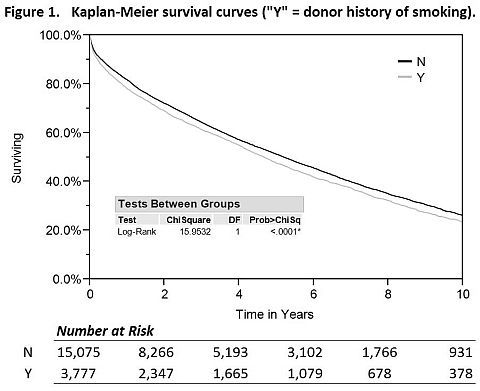Lung Transplant with Allografts from Donors with a History of Smoking: A Nationwide Analysis of Usage and Outcomes
Duke University Medical Center, Durham, NC
Meeting: 2013 American Transplant Congress
Abstract number: 245
Lung transplant with allografts from donors with a history of smoking is controversial; however, this practice has never been evaluated on a national level in the United States (US). Our objective was to compare US lung transplant outcomes with allografts from smoking vs. non-smoking donors.
METHODS: Adult, first, lung-only transplants in the OPTN/UNOS database from 1994-2011 were analyzed. Smoking donors were defined as >20 pack-year smoking history. The Cochran-Armitage trend test was used to assess trends in smoking donor utilization. Survival curves were estimated by the Kaplan-Meier method and compared by the log-rank test. Early and late postoperative complications and mortality were assessed using multivariable logistic regression and Cox proportional hazard modeling.
RESULTS: 18,852 patients were included. Recipients of smoking donor allografts compared to recipients of non-smoking donors had significantly increased waitlist times and incidence of obstructive lung disease (p<0.0001 for both), but were similar in age and comorbidity profile. The percent of transplants from smoking donors steadily declined from 37.8% in 1994 to 8.4% in 2011 (p<0.0001). Recipients with smoking donors had lower unadjusted survival (Figure 1) and upon multivariable analysis demonstrated increased risk of airway dehiscence, postoperative length of stay >25 days (75th percentile), and dialysis prior to discharge [adjusted odds ratio (AOR): 1.41, 95% confidence interval (CI): 1.01-1.97, p=0.04; AOR: 1.18, CI: 1.06-1.32, p=0.002; AOR: 1.20, CI: 1.01-1.43, p=0.03, respectively].

Recipients with smoking donors also demonstrated increased 1-year and 5-year mortality (AOR: 1.14, CI: 1.04-1.25, p=0.006; AOR: 1.12, CI: 1.03-1.23, p=0.01, respectively) as well as increased Cox proportional hazard risk of death (adjusted hazard ratio: 1.09, CI: 1.04-1.15, p=0.0005).
CONCLUSION: Lung transplant recipients with smoking donors demonstrate worse early and late postoperative outcomes; however, this must be balanced against potential increase in waitlist mortality by excluding this donor pool.
To cite this abstract in AMA style:
Castleberry A, Speicher P, Worni M, Snyder L, Osho A, Pietrobon R, Palmer S, Davis R, Hartwig M. Lung Transplant with Allografts from Donors with a History of Smoking: A Nationwide Analysis of Usage and Outcomes [abstract]. Am J Transplant. 2013; 13 (suppl 5). https://atcmeetingabstracts.com/abstract/lung-transplant-with-allografts-from-donors-with-a-history-of-smoking-a-nationwide-analysis-of-usage-and-outcomes/. Accessed December 23, 2025.« Back to 2013 American Transplant Congress
